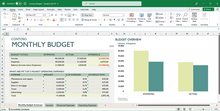Microsoft Excel Features and Functions
– Developed by Microsoft for Windows, macOS, Android, iOS, and iPadOS
– Offers calculation and computation capabilities
– Includes graphing tools
– Supports pivot tables
– Features a macro programming language called Visual Basic for Applications (VBA)
– Excel 2016 has 484 functions
– 360 functions existed prior to Excel 2010
– Functions are classified into 14 categories by Microsoft
– 386 functions can be called from VBA as methods of the object WorksheetFunction
– 44 functions have the same names as VBA functions
Macro Programming with VBA
– VBA programming allows spreadsheet manipulation that is awkward or impossible with standard techniques
– VBA code is written using the Visual Basic Editor (VBE)
– VBA code can automate tasks like formatting and data organization
– VBA code interacts with the spreadsheet through the Excel Object Model
– VBA was removed from Mac Excel 2008 but restored in Mac Excel 2011
Charts and Graphs
– Excel supports charts, graphs, and histograms generated from specified groups of cells
– Pivot Charts can be linked directly to a Pivot table for dynamic updates
– Charts can be embedded within the current sheet or added as separate objects
– Charts can assist in visualizing design requirements and selecting the best design
– Excel also supports the creation of dynamic and interactive charts
File Formats in Microsoft Excel
– Excel is backwards-compatible with traditional binary formats
– Most versions of Excel can read CSV, DBF, SYLK, DIF, and other legacy formats
– Support for some older file formats was removed in Excel 2007
– OpenOffice.org has created documentation of the Excel format
– Two epochs of the format exist: the 97-2003 OLE format and the older stream format
– XML Spreadsheet format was introduced in Excel 2002
– It is a simple, XML-based format missing some advanced features like storage of VBA macros
– The intended file extension for this format is .xml, but it also handles .xls files correctly
– Excel 2007 introduced new file formats
– The default format is .xlsx, a ZIP compressed archive with XML text documents
– .xlsx is the primary replacement for the former binary .xls format
– .xlsm is an Excel Macro-enabled Workbook with macro support
– .xlsb is an Excel Binary Workbook that stores information in binary form for faster document handling
– .xls is the main spreadsheet format that holds data, charts, and macros
– .xla is an add-in (VBA) that adds custom functionality
– .xlb is the file extension for custom toolbar settings
– .xlc is a chart created with data from an Excel spreadsheet
– .xld is used in older versions of Excel
Using Excel with Other Applications and External Data
– Windows applications like Access, Word, and Excel can communicate and use each other’s capabilities
– Dynamic Data Exchange (DDE) is a common method to send data between applications on Windows
– OLE Object Linking and Embedding allows one application to control another for formatting or calculating data
– Financial markets often use DDE to connect to important financial data services
– Applications can be embedded in each other, like a PowerPoint presentation embedded in an Excel spreadsheet
– Excel users can access external data sources through Office features like .odc connections
– Excel can accept real-time data through programming interfaces and add-ins like Power Plus Pro
– Dynamic Data Exchange (DDE) allows data flow between Excel and other applications
– Network DDE extended the protocol to exchange data between spreadsheets on different computers
– Real Time Data (RTD) is technically superior to DDE but has been slow to gain acceptance
– APIs have been developed to open Excel spreadsheets in various applications and environments
– ActiveX controls and plugins like Adobe Flash Player can open Excel documents on the web
– The Apache POI project provides Java libraries for reading and writing Excel spreadsheet files.
Microsoft Excel is a spreadsheet editor developed by Microsoft for Windows, macOS, Android, iOS and iPadOS. It features calculation or computation capabilities, graphing tools, pivot tables, and a macro programming language called Visual Basic for Applications (VBA). Excel forms part of the Microsoft 365 suite of software.
 | |
 A simple bar graph being created in Excel, running on Windows 11 | |
| Developer(s) | Microsoft |
|---|---|
| Initial release | November 19, 1987 |
| Stable release | 2309 (16827.20130)
/ September 28, 2023 |
| Written in | C++ (back-end) |
| Operating system | Microsoft Windows |
| Type | Spreadsheet |
| License | Trialware |
| Website | microsoft |
 Excel for Mac (version 16.67), running on macOS Big Sur 11.5.2 | |
| Developer(s) | Microsoft |
|---|---|
| Initial release | September 30, 1985 |
| Stable release | 16.70 (Build 23021201)
/ February 14, 2023 |
| Written in | C++ (back-end), Objective-C (API/UI) |
| Operating system | macOS |
| Type | Spreadsheet |
| License | Proprietary commercial software |
| Website | products |
 Excel for Android running on Android 13 | |
| Developer(s) | Microsoft Corporation |
|---|---|
| Stable release | 16.0.16501.20160
/ May 26, 2023 |
| Operating system | Android Pie or later |
| Type | Spreadsheet |
| License | Proprietary commercial software |
| Website | products |
| Developer(s) | Microsoft Corporation |
|---|---|
| Stable release | 2.73
/ May 15, 2023 |
| Operating system | iOS 15 or later iPadOS 15 or later |
| Type | Spreadsheet |
| License | Proprietary commercial software |
| Website | products |
1912 NW 143rd Ave #24,
Portland, OR 97229, USA